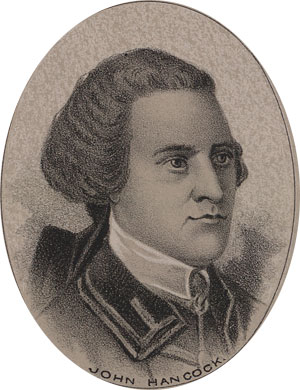
Signers of the Declaration of Independence
Short biographies on each of the 56 Declaration signers
John Hancock
1737-1793
Representing Massachusetts at the Continental Congress

| Born: | January 12, 1737 |
| Birthplace: | Braintree (Quincy), Mass. |
| Education: | Graduated Harvard College (Merchant.) |
| Work: | Elected to the Boston Assembly, 1766; Delegate to, and President of, the Provincial Congress of Massachusetts, circa 1773; Elected to Continental Congress, 1774; Elected President of the Continental Congress, 1775; Member of Massachusetts state Constitutional Convention, elected Governor of Massachusetts, through 1793. |
| Died: | October 8, 1793 |
The signature of John Hancock on the Declaration of Independence is the most flamboyant and easily recognizable of all. It is perhaps no surprise that the story of his part in the revolution is equally engaging. Few figures were more well known or more popular than John Hancock.
He played an instrumental role, sometimes by accident, and other times by design, in coaxing the American Revolution into being.
Born in Braintree, Massachusetts in 1737, he was orphaned as a child, and adopted by a wealthy merchant uncle who was childless. Hancock attended Harvard College for a business education and graduated at the age of 17. He apprenticed to his uncle as a clerk and proved so honest and capable that, in 1760, he was sent on a business mission to England.
There he witnessed the coronation of George III and engaged some of the leading businessmen of London. In 1763, his uncle died and John Hancock inherited what was said to be the greatest body of wealth in New England.
This placed him in a society of men who consisted mainly of loyalists, suspected by the working population because of their great affluence and social power.
Hancock, however, soon became very involved in revolutionary politics and his sentiments were, early on and clearly, for independence from Great Britain.
He was in company with the Adamses and other prominent leaders in the republican movement in New England. He was elected to the Boston Assembly in 1766, and was a member of the Stamp Act Congress.
In 1768 his sloop Liberty was impounded by customs officials at Boston Harbor, on a charge of running contraband goods. A large group of private citizens stormed the customs post, burned the government boat, and beat the officers, causing them to seek refuge on a ship off shore. Soon afterward, Hancock abetted the Boston Tea Party.
The following year he delivered a public address to a large crowd in Boston, commemorating the Boston Massacre. In 1774, he was elected to the Provincial Congress of Massachusetts and simultaneously to the Continental Congress. When Peyton Randolph resigned in 1776, Hancock assumed the position of President. He retired in 1777 due to problems with gout, but continued public service in his native state by participating in the formation of its constitution. He was then elected to the Governorship of the state where he served for five years, declined reelection, and was again elected in 1787. He served in that office until his death in 1793. The dignity and character of John Hancock, celebrated by friend and enemy alike, did not suffer for his love of public attention. He was a populist in every sense, who held great confidence in the ability of the common man. He also displayed a pronounced contempt for unreasoned authority. A decree had been delivered from England in early 1776 offering a large reward for the capture of several leading figures. Hancock was one of them.
The story, entirely unfounded, is that on signing the Declaration, Hancock commented, "The British ministry can read that name without spectacles; let them double their reward." An alternate story, also unfounded has him saying, "There, I guess King George will be able to read that!" He was the first to sign and he did so in an entirely blank space.
Start page | The Document | A Reading | Signers | Related Information | Jefferson's Account | Declaration House | Declaration Timeline | Rev. War Timeline | More Resources |





